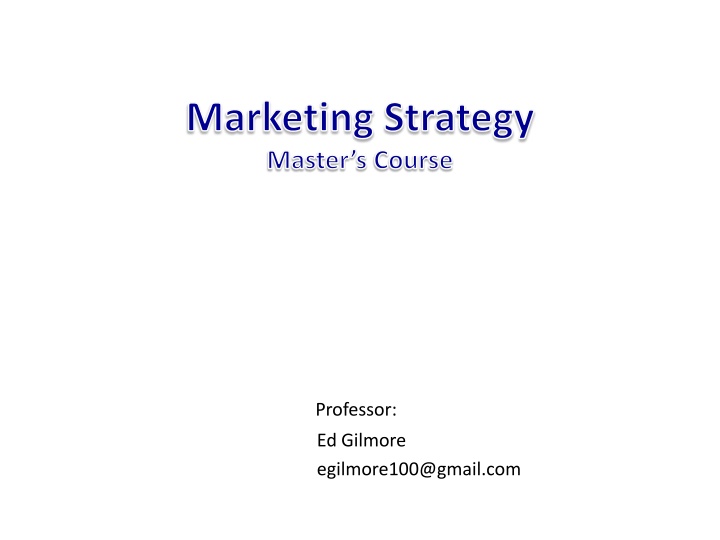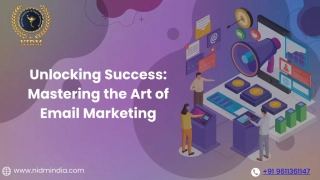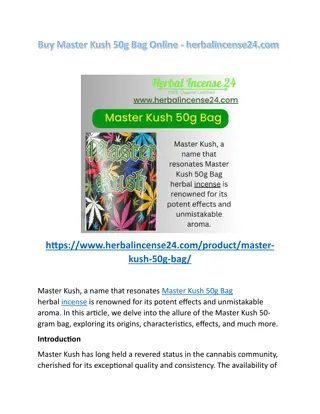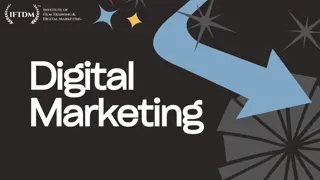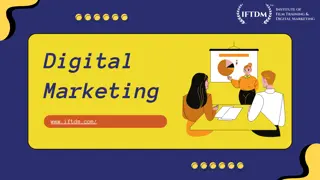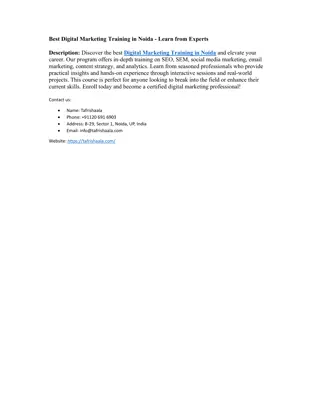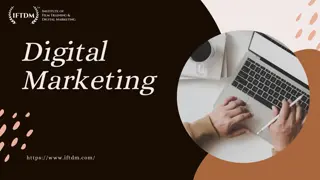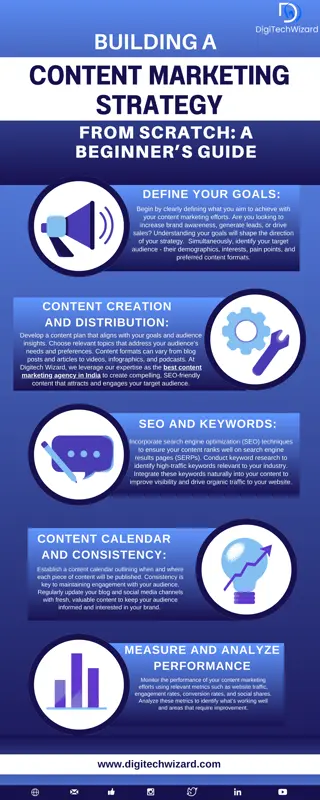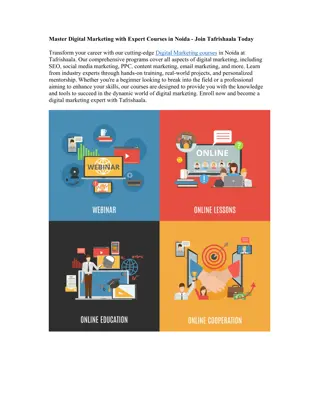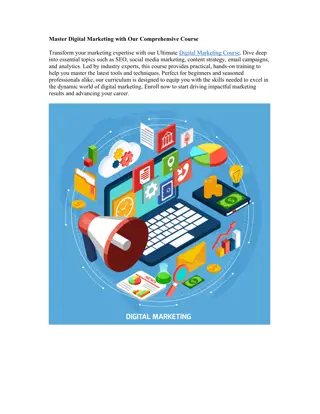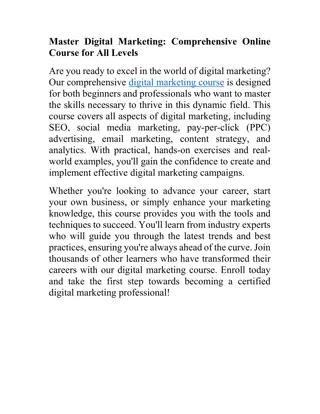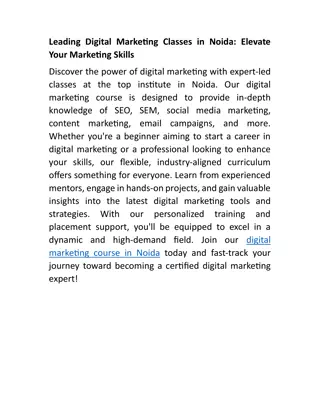Comprehensive Marketing Strategy Master's Course by Professor Ed Gilmore
Dive into the world of marketing with Professor Ed Gilmore's comprehensive course covering key areas such as personal branding, product creation, strategic planning, retail strategies, advertising, and more. Learn problem-solving, creative thinking, and formal presentation skills while engaging with industry experts. Explore practical applications of marketing theory through real business problems in a workshop setting. Reference materials include renowned books like "Marketing (5th Edition)" and "Like a Virgin" by Richard Branson. Join this course to enhance your marketing knowledge and skills!
Download Presentation

Please find below an Image/Link to download the presentation.
The content on the website is provided AS IS for your information and personal use only. It may not be sold, licensed, or shared on other websites without obtaining consent from the author.If you encounter any issues during the download, it is possible that the publisher has removed the file from their server.
You are allowed to download the files provided on this website for personal or commercial use, subject to the condition that they are used lawfully. All files are the property of their respective owners.
The content on the website is provided AS IS for your information and personal use only. It may not be sold, licensed, or shared on other websites without obtaining consent from the author.
E N D
Presentation Transcript
Marketing Strategy Master s Course Professor: Ed Gilmore egilmore100@gmail.com
Course objectives Understanding the key areas of marketing and the practical application of .Personal marketing, branding, principles of product creation, devising a strategic marketing plan, selling and distribution, retail strategies, advertising, media placement and monitoring, corporate communication, PR, customer care. Problem solving, individually and in groups Analysis, creative thinking: using marketing theory and applying it to hypothetical cases Learning to formally present your ideas Listening/interacting/learning with me and from guest experts
Format and Approach A practical understanding of marketing
Format and Approach A practical understanding of marketing - using marketing theory to solve real business problems.
Format and Approach A practical understanding of marketing - using marketing theory to solve real business problems. Presentation of marketing theory
Format and Approach A practical understanding of marketing - using marketing theory to solve real business problems. Presentation of marketing theory The class is a workshop - problem solving and exchange of ideas
Format and Approach A practical understanding of marketing - using marketing theory to solve real business problems. Presentation of marketing theory The class is a workshop - problem solving and exchange of ideas Individual & group creative thinking
Reference Material Marketing (5 edition) - Baines, Fill - Oxford press Like a Virgin -Secrets they won't teach you at business school by Richard Branson ** For every class you will receive all the slides presented. You are responsible for all the material in the slides. The above Text Book is a valuable reference, but not obligatory for the class.
Richard Branson: Here's how to get anyone to listen to your idea "The pitches that I remember, and resulted in support and investment, were the ones where the idea could have fitted on the back of an envelope" "If you want to get your message across, be engaging, concise and to the point," he advises. "Then, when you are done saying what you have to say, stop saying it."
Course grading Group Presentations............ 30% Individual written report ... 15% Class participation............... 15% Final Exam .......................... 40% Pay attention, learn and contribute !
Personal Marketing If marketing involves selling, you should first try to "sell yourself."
INTROS (The first lesson in effective marketing sell yourself !! Who am I ? Who are you ?
Elevator Pitch Name What company and where Your position The key point of your company (all in 20 seconds !!)
What is marketing ?? It is many things to different people
History The origins of the concept of marketing have their roots with the Italian economist Giancarlo Pallavicini in 1959 !!! Giancarlo Pallavicini introduces the following definitions: 1) Marketing is defined as a social and managerial process designed to meet the needs and requirements of consumers through the processes of creating and exchanging products and values. 2) It is the art and science of identifying, creating and delivering value to meet the needs of a target market, making a profit : delivery of satisfaction at a price.
Definitions mar ket ing [mahr-ki-ting] 1. the act of buying or selling in a market. 2. The total of activities involved in the transfer of goods from the producer or seller to the consumer or buyer, including advertising, shipping, storing, and selling. 3. (from the Chartered Institute of Marketing): The management process of anticipating,identifying, and satisfying customer requirements profitably. 4. (from the American Marketing Association): Marketing is the activity, set of institutions, and processes for creating, communicating, delivering, and exchanging offerings that have value for customers, clients, partners, and society at large. ** 5. Marketing is the process of communicating the value of a product or service to potential customers, for the purpose of selling that product or service and creating brand loyalty.
Understanding a complex concept like Marketing Why is it fundamental ? Can you start a business without it ? What is the most important part of marketing ? What area of a business is really outside the scope of marketing ?
Elements of Marketing management Product idea and creation Market research (trends, consumer taste, competition, pricing, etc) Financial analysis for product viability Strategic analysis (target market) Product testing Marketing plan Pre-advertising/promotion Training of sales force Launch activity Full advertising/promotion activity Distribution-Product placement Monitoring sales activity Post launch analysis Strategic planning revisions based on feedback/results Customer service Communication PR for product and brand management
Marketing minestrone Mass media used to build a brand Television, radio Sponsorship deals Display advertising (newspapers,magazines, on internet) Advertorials Brochures/Catalogues Yellow pages Billboard Advertising Price promotions and discounting Coupons Promotional events Packaging Competitions and prizes Refunds/rebates Loyalty incentives (supermarket cards) Point of sale displays Internet marketing/advertising Search marketing: to optimize positioning Email marketing: direct communication with permission Mobile marketing: phone and wireless world Online retailing: (B2C) shopping, click, order, have delivered Advergaming: Video & online games to advertise/brand Social media marketing: using social networks to produce content that users will share Virtual reality, AR, AI Viral marketing: using promotions, ideas, clips to pass on
Understand and choose First have a fundamental understanding of what the elements are. Choose the combination of elements to make a strategy to "market" your product or service.
Our focus The understanding and application of marketing theory: As a future (or current) executive you must know the importance of employing the marketing philosophy in nearly all aspects of your company. Critical thinking yes, but more important, creative thinking ..... connecting to the outside world, looking to the future.
MARKETING MIX The 4 P s +1 PRODUCT PLACE POSITIONING PRICE PROMOTION
Product The product is the physical product or service offered to the consumer. In the case of physical products, it also refers to any services or conveniences that are part of the offering. Product decisions include aspects such as function, appearance, packaging, service, warranty, etc.
Price Pricing decisions should take into account profit margins and the probable pricing response of competitors. Pricing includes not only the list price, but also discounts, financing, and other options such as leasing.
Place Place (or placement) decisions are those associated with channels of distribution that serve as the means for getting the product to the target customers. The distribution system performs transactional, logistical, and facilitating functions. Distribution decisions include market coverage, channel selection, logistics, and levels of service.
Promotion Promotion decisions are those related to communicating and selling to potential consumers. It is useful to know the value of a customer in order to determine whether additional customers are worth the cost of acquiring them. Promotion decisions involve analytical research, selection of targeted customer clusters, creative insights to make visual and written messages, media channel selection, managed advertising programs, continual monitoring and adjusting ADV campaigns, etc.
Positioning Positioning refers to the place that a brand occupies in the mind of the customer and how it is distinguished from products from competitors. Primarily, it is about "the place a brand occupies in the mind of its target audience". Once that perceived image is fixed, it is difficult to re-position. Some types: Value for the money, quality, service honesty, well-established, positive reputation (my friends like it ! ) Positioning is one of the most powerful marketing concepts.
Add People also ? People decisions are those related to customer service. How do you want your workers to appear to your customers? The function of people is to present an appearance, an attitude which should reflect the values of the company & the brand.
Starting a Business Where do I begin ? What things must I decide before I spend any money ? What are most important elements of planning ?
Marketing in 5 simple questions: Who are the customers and where are they ? What does the customer want ? Why does the customer make a purchase ? Why will a customer choose to buy my product ? How should my company sell to the customer ?
Customer is King The 'Customer orientation' is perhaps the most common element used in contemporary marketing. It involves a firm essentially basing its marketing plans around the fundamental marketing concept, and thus supplying products to suit new consumer tastes. The goal of reaching a customer and presenting your product well, used to be the number one goal. Now, Customer Engagement is the buzzword of modern marketers.
Marketing Marriage Company Customer Product
First, have an identity What is the identity of your company, your uniqueness, your value ? How can you sell a product or service if you can't communicate the value and quality to the public. That identification, that perception of the company and product in the mind of the consumer (remember Positioning ! )
Make a positioning graph (price/quality) La Rinascente Zara UPIM Max Mara Armani
S.W.O.T. Analysis To determine an organization s strategic position A way to identify four Key elements that have an impact on strategy The matrix created forms a basis for discussion of strategic planning
S.W.O.T. Strengths Weaknesses Opportunities Threats
S.W.O.T. example Strengths Weaknesses Quick to respond to changes in the marketing environment Flat management encourages fast decision making Use of outside contractors enables flexibility ( Lowers employment costs/finance and improves customers perception of expertise) Too much work from few clients and at non-premium prices Few Project management skills High office and finance costs Small base of customers Opportunities Threats Emerging markets such as Professional Services (e.g.dentists,lawyers,surveyors) New distribution channels Tax incentives to encourage purchasing e-Commerce is a growing market Larger capitalized companies gaining market share Speed of technological advances Contractors have low levels of loyalty
Class Project Write a S.W.O.T. analysis of your company, choosing the key elements of its product or services that you believe characterize it s current situation and outlook for the future. What are, in your opinion, some marketing options for your company to eliminate some weaknesses and increase market share ?
What, no job ? Choose: McDonald's Alitalia Prada Vodafone
Homework Next week the theme of the class is Branding. Think about this question: Is Branding important in Marketing ? Inform yourself and have an opinion.
